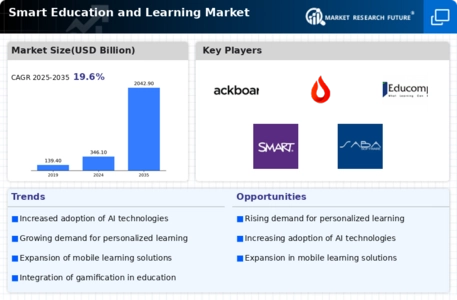Market Share
Smart Education and Learning Market Share Analysis
The Smart Education and Learning market has seen remarkable growth in recent years due to technological advances and increasing demand for new pedagogical solutions. The major trend in the market is the widespread use of digital learning platforms that employ artificial intelligence, virtual reality, and augmented reality technologies to improve student experiences. Smart education tools enable students and educators to connect seamlessly regardless of their geographical locations, hence fostering inclusivity. Furthermore, there has been an increased movement towards online courses and mobile learning apps. These systems allow flexibility while still creating convenience for learners as they access instructional content at their comfort levels, even when on the move. Also, a notable trend in the Smart Education and Learning market is the merging of data analytics and machine learning algorithms to allow personal learning experiences. Institutions of higher learning and tech corporations are using insights from data to customize content for various ways and preferences that different students learn best. Meanwhile, gaming education is becoming popular as a new way to improve learners' involvement and make it more fun. In educational materials, gamified learning platforms use game principles, which include competition, rewards, or interactive parts. Such developments not only attract students with an interest in technology but also lead to deeper and more engaging learning. Collaborative tools have become key ingredients for smart education, where students and their lecturers interact in real time. Virtual classrooms, videoconferencing, and collaborative document editing are now common features in smart education platforms. Many innovations in smart education have been driven by artificial intelligence (AI), hence making it one of the major forces behind its development. AI-powered chatbots help learners with questions, thus providing immediate support at any time there is a need for it. Besides, AI techniques analyze massive amounts of educational data in search of patterns worth noting so that institutions can make wise decisions based on this data type, enhancing overall study results. Moreover, IoT has penetrated smart education. The Internet of Things (IoT) has found its way into smart education through connected devices as well as sensors to enhance the teaching environment. Smart classrooms fitted with IoT devices enable constant monitoring of progress made by students, such as attendance records and engagement levels. This implies that lifelong learning and upskilling have increasingly become important components within the development trajectory of the intelligent education industry. With technological advancement moving at break-neck speed, people realize they must keep updating their skills continuously. To cater to an international workforce looking to stay ahead in a fast-transforming employment arena, intelligent training offers numerous courses both online and offline. Companies are developing e-learning programs primarily because they believe in maintaining their personnel's skill-based learning. Organizations adopt intelligent education because of the increasing demand for e-learning solutions to support worker development, improve productivity, and cope with the changing business environment. It is this continuous corporate focus on learning that has redefined the smart education market, thus driving the growth of more tailored professional development sector solutions.








Leave a Comment